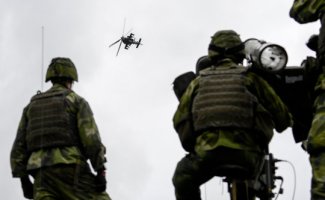Sweden bets on the Patriot

On 7 November, the Swedish government commissioned the Swedish Defence Materiel Administration (FMV) to open negotiations with the US government and submit a Letter of Request to purchase the Patriot medium-range air and missile defence system. The Swedish government is expecting a detailed offer from the United States in the spring of 2018. Next year will also see Sweden’s final decision on buying the air-defence system. Stockholm wants delivery to begin in 2020, and the system to be operational by 2025. Hence, the deal will most likely not include offset agreements, and will not involve Swedish industry. The purchase of the medium-range air defence system is part of the 2016-2020 defence strategy adopted in 2015 by the Swedish government and parliament, with the support of the opposition.
Commentary
- The decision to start negotiations with the US to purchase the Patriot air-defence system has an important political context. Since 2014 Sweden’s priority has been closer political and military cooperation with the United States (alongside more intensive cooperation with NATO and Finland). Sweden does not belong to NATO, but treats the US as the guarantor of the security in the Baltic Sea region. In June 2016 both countries signed a bilateral statement of intent that envisaged enhancing interoperability, training and exercises, deepening armament cooperation, advancing joint research and development, and cooperating in multinational operations. The dynamic development of US-Swedish military cooperation has been evidenced by the participation of 1300 US soldiers in September this year in Aurora 17, Sweden’s biggest national defence exercises since the 1990s. Because of the priority given to strengthening cooperation with the US, the Swedish defence ministry prefers the Patriot system (and not the competing French-Italian SAMP/T), and regards the purchase as the beginning of long-term military-technical cooperation in the area of surface-to-air defence - a key defence capability in the Baltic Sea region.
- The purchase of the Patriot air-defence system and the cooperation with the US is supported both by the minority government formed by the Social Democrats and the Green Party and the conservative opposition (the Moderates and the Centre Party, as well as the Liberals and Christian Democrats). The criticism of the decision has come from the far-right Sweden Democrats, who favoured the choice of the SAMP/T air-defence system. Since there is cross-party support for the purchase of the Patriot system and the development of cooperation with the US, it is unlikely that Stockholm will change its position on the matter, even after a possible change of government (general elections will take place in September 2018; the Sweden Democrats, isolated by other parties in the Parliament, stand no chance of joining the government).
- The purchase of the medium-range air-defence system is a part of the modernisation of Sweden’s air defence, which was drastically reduced after the end of the Cold War. In the structures of the Swedish Army there is only one Air Defence Regiment with two air defence battalions left (with around 450 full-time soldiers and around 500 reserve soldiers). It is based in Halmstad on the southwest coast of Sweden. These battalions are equipped with air defence systems dating from the 1960s and 1970s: the Swedish-made very short range RBS 70 MANPADS (range 6-7 km, ceiling 3-4 km) and the short-range RBS 97 (the upgraded version of the American-made MIM-23 Hawk system, range 40 km and ceiling 18 km). In the future, the RBS 70 system should be replaced by the German-Swedish IRIS-T SLS system (range up to 10 km, ceiling up to 5 km), whose delivery will probably start, after a two-year delay, in 2019. In turn, the RBS 97 systems should be replaced by the medium-range Patriot system. The current location of the Air Defence Regiment in Halmstad is the result of a process of rationalisation and reduction in the structures of the Swedish Army. It is likely that the modernisation of the Swedish air defence will start a discussion about relocating the systems, in order to protect: (1) key civilian and military infrastructure in the Stockholm-Mälaren region, (2) the main base of the Blekinge Air Force Wing in Ronneby (F 17, one of the three wings in the Swedish Air Force) and Sweden’s main naval base in Karlskrona (South Sweden), and (3) the strategically important island of Gotland.
- Sweden is likely to purchase the Patriot system in the PAC3 configuration which is currently under production, as used by US forces, though it may choose to purchase the American-Israeli SkyCeptor missiles. Media reports show that the Swedes want to buy only four firing units. According to the FMV Administration, the cost of the purchase will exceed 10 billion Swedish kronor (about US$1.2 billion), but there are also reports in the media that the value of the tender may increase significantly. It remains an open question as to whether the purchase of the air-defence system, together with the implementation of two other large modernisation programs (the purchase of 60 new JAS 39 fighters, and of new submarines) would not be too big a burden on the Swedish defence budget. Without additional funds for Swedish Armed Forces, this may negatively affect the purchase of basic materials and military equipment, as well as the training activity of the Swedish military. According to data from SIPRI, the Swedish defence budget in 2016 amounted to 45.5 billion Swedish kronor (US$5.3 billion), which accounted for 1% of GDP (military spending has remained at this level for almost a decade). In 2015, it was agreed that total military spending in the 2016-2020 period would rise by an additional 10.2 billion Swedish kronor (US$1.3 billion), although this would not be enough to meet the modernisation demands of the underfunded Swedish military.




